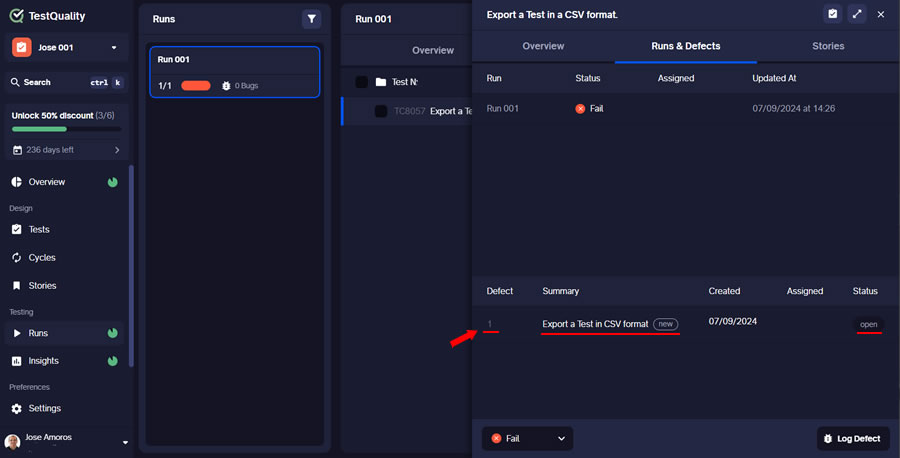Introduction
In the dynamic realm of software development, defect management plays a pivotal role in ensuring the delivery of high-quality software products. A structured approach to identifying, documenting, and resolving defects not only enhances software quality but also optimizes resources and timelines. This guide delves into the essentials of defect management, tailored for QA professionals, software testers, and developers, while highlighting the benefits of using TestQuality's advanced test management solutions.
What is Defect Management in Software Testing?
Defect management is the systematic process of detecting, documenting, and resolving defects within software applications. A defect refers to any flaw or deviation from the expected behavior, which can arise from coding errors, incorrect logic, incomplete implementations, or unforeseen interactions between software components. These defects can manifest as functionality issues, performance degradation, security vulnerabilities, or unexpected behaviors, impacting the overall user experience and software reliability.
Importance of Defect Management
1. Enhanced Software Quality: Early identification and resolution of defects significantly improve overall software quality. This leads to a better user experience, increased customer satisfaction, and helps maintain a competitive edge in the market.
2. Risk Reduction: By identifying and addressing issues early in the development process, defect management minimizes risks associated with software failures. This proactive approach helps prevent potential issues that could harm user experience and brand reputation.
3. Continuous Improvement: A robust defect management process provides valuable feedback for continuous improvement. Analyzing the root causes of defects allows development teams to implement proactive measures to prevent similar issues in the future, fostering long-term software excellence.
4. Prompt Issue Resolution: A structured defect management process ensures that no defect goes unnoticed, enabling developers to address issues promptly. This quick resolution supports efficient project management and helps keep development on track for meeting deadlines.
5. Cost Efficiency: Effective defect management reduces the need for costly post-release fixes, saving time and resources. It also helps avoid expenses associated with handling customer complaints and support issues, ultimately contributing to overall cost efficiency.
6. Enhanced Collaboration: Defect management encourages collaboration among developers, testers, and other stakeholders. This collective effort ensures that defects are prioritized correctly and resolved efficiently, improving the overall development process.
Defect Management Process
1. Defect Prevention
- Proper Planning and Risk Assessment: At the project's outset, it's crucial to evaluate resources, tools, and potential error sources to prevent defects. Understanding team dynamics, available tools, and potential risks helps in anticipating and mitigating issues before they arise.
- Implementation of Standard Procedures: Standardizing procedures, methodologies, and practices ensures consistency across development phases, reducing the likelihood of defects caused by inconsistent practices.
- Comprehensive Documentation: Creating detailed documentation on requirements, specifications, and coding styles is essential. Clear and accessible documentation helps mitigate errors resulting from misunderstandings or incomplete information.

Don't wait - Experience the full power of TestQuality and see how it streamlines test creation, collaboration, automation testing and defect management all-in-one place.
Start your Free Trial Now!
Sign up now and enjoy a 14-day free trial (no credit card required).
2. Detecting and Identifying Defects
Various types of testing, including unit testing, integration testing, and acceptance testing, are crucial for detecting defects early. Testing under real user conditions is vital for accurate defect detection, as emulators and simulators may not always provide 100% accurate results.
Once detected, defects should be logged and reported in detail. Developers then evaluate each defect to determine its priority for immediate resolution or rejection if deemed a misreported issue.
3. Defect Triage and Categorization
Categorizing defects based on severity and impact helps in prioritizing and planning their resolution. The categories typically include:
- Critical: Defects that prevent the software from being used.
- High: Defects affecting core product functions.
- Medium: Minor deviations from product requirements.
- Low: Minor bugs causing slight inconvenience to users.
Proper defect triage ensures that high-priority issues are addressed quickly while still managing lower-priority defects to enhance overall software quality.
4. Defect Logging
Utilizing defect management tools like TestQuality is crucial for logging, tracking, and managing defects. Assigning unique IDs to defects and designating ownership ensures accountability and timely resolution.
Detailed defect logging includes information such as the defect ID, description, severity, priority, steps to reproduce, and screenshots or logs. This comprehensive information aids developers in understanding and resolving the defect efficiently.
5. Defect Resolution
Developers prioritize defects based on severity and work on fixing them. Automated testing tools and frameworks play a significant role in identifying and resolving defects more quickly and efficiently.
Collaborative tools enable seamless communication between developers and testers, ensuring that fixes are verified promptly and accurately.
6. Defect Verification
Testers verify that defects have been fixed correctly without introducing new issues. If a defect is not fixed properly, it is sent back to developers for further action. This iterative process continues until the defect is resolved satisfactorily.
7. Defect Closure
Once verified, defects are closed in the tracking system. Closed defects are reported to management for feedback and documentation. This final step ensures that the defect management process is complete and that all stakeholders are informed of the resolution.
How TestQuality Enhances Defect Management
TestQuality stands out as an advanced defect management tool designed to integrate seamlessly with GitHub and Jira workflows. It supports a wide range of test automation and unit testing tools, offering a collaborative environment for managing defects effectively.

TestQuality offers you the possibility to create a defect or bug directly from a test in a test run. This TestQuality feature allows immediate logging of issues, ensuring a streamlined defect tracking process.

By clicking on the 'Log Defect' button located at the bottom right, you will be able to log a defect and ensuring a streamlined defect tracking process.

The Test Drawer is where you can manage and log details related to the test. In case that there is no integration set up with a defect tracking system (like GitHub or Jira), you will be prompted to set up an integration before you can proceed logging a defect..

Defects can be created by using your own defect template that you can edit to better match your use case, or your preferred format of issues in Jira or GitHub. Here, you can edit fields as needed, such as Priority or labels.

In order to view the created defect in TestQuality, you may select the 'Runs & Defects' tab in the test drawer.

This "Runs & Defects" Tab allows you to manage and monitor all logged defects associated with your tests.

Your new defect is now created in your linked repository on GitHub or Jira. TestQuality does not save a local version of the defect but rather references a link to it in the test.

The "Activity" tab, logs any changes made to the test. The option to "Leave a comment" can be used to add notes, attach images, documents, or just leave messages to your team colleagues regarding the test.
Thanks to these collaborative features that TestQuality offers, it ensures that everyone is on the same page, from testers to developers, with real-time updates and shared visibility into the defect management process. No more confusion or missed information – just efficient teamwork that streamlines your testing workflow.

Key Benefits of TestQuality's Collaborative Defect Management:
- Improved Communication and Collaboration: TestQuality fosters improved communication and collaboration among team members, ensuring that everyone is aligned and informed throughout the defect management process.
- Enhanced Visibility: The tool provides enhanced visibility into the defect resolution process, allowing stakeholders to track progress and make informed decisions.
- Streamlined Workflow: TestQuality streamlines the workflow for identifying, prioritizing, and resolving defects, making the process more efficient and effective.
- Reduced Time and Effort: By automating various aspects of defect management, TestQuality reduces the time and effort required for defect resolution, leading to faster turnaround times.
- Increased Efficiency and Productivity: The tool's features and integrations help increase the efficiency and productivity of software development teams, enabling them to deliver high-quality software on time.
Conclusion
Defect management is an essential component of the software development lifecycle, crucial for delivering high-quality software that meets user expectations. By adopting a systematic and collaborative approach, utilizing tools like TestQuality, and continuously refining processes, organizations can significantly reduce defects, improve software quality, and achieve greater customer satisfaction. Embrace defect management as a core practice to enhance your software development lifecycle and maintain a competitive edge in the market. Effective defect management not only ensures software reliability but also fosters a culture of continuous improvement and excellence within development teams.

By leveraging TestQuality’s advanced features and collaborative environment, QA professionals, software testers, and developers can optimize their defect management processes, resulting in superior software products and satisfied customers.
TestQuality Team





